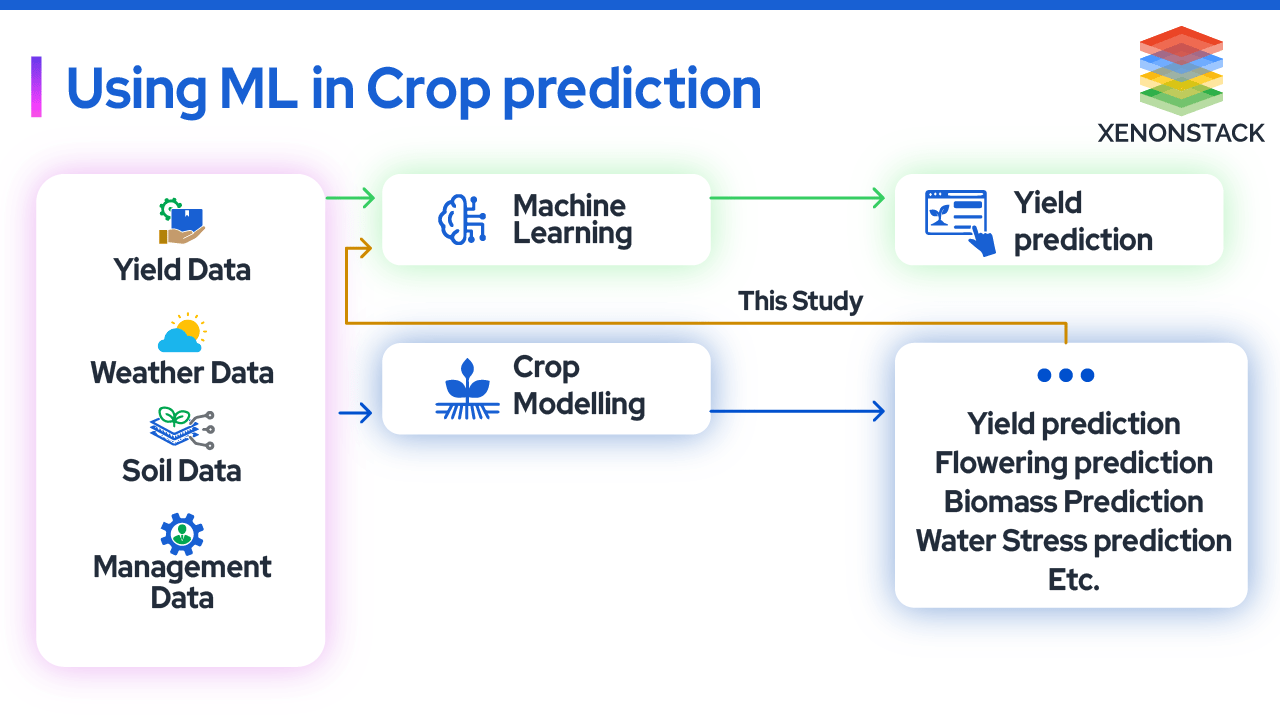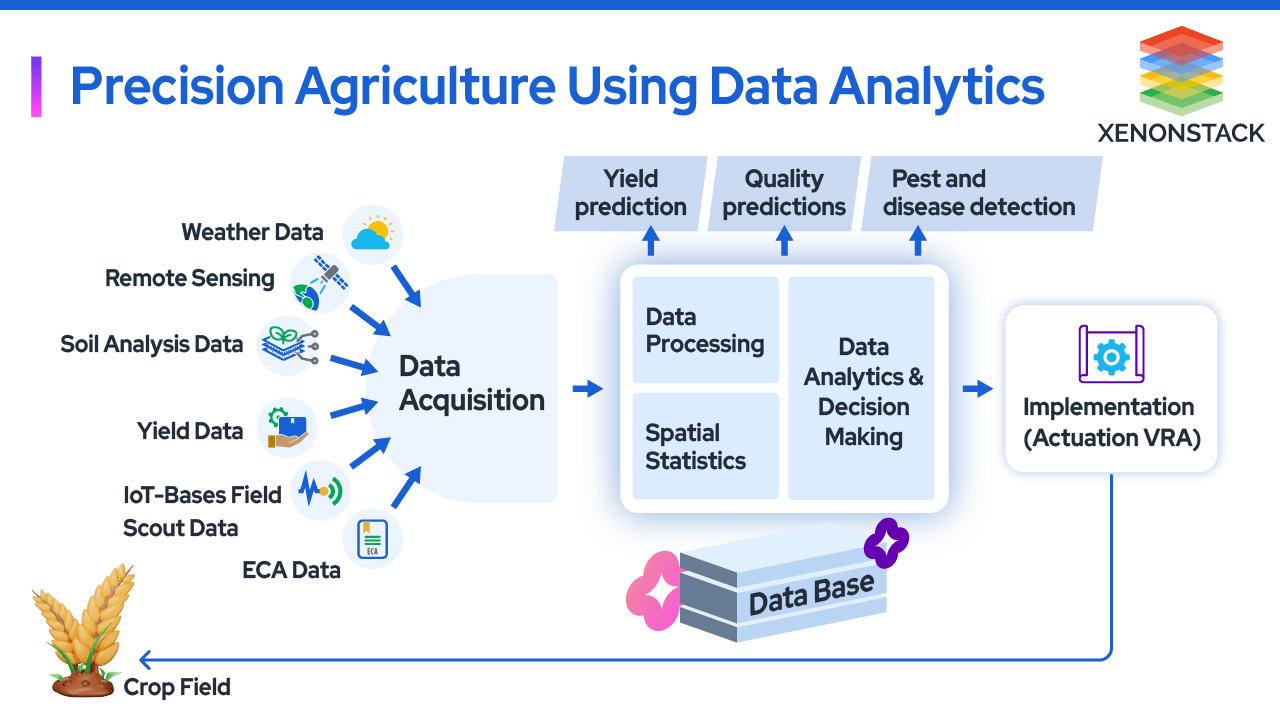Introduction
In contemporary agricultural practices, data has emerged as a valuable tool for making well-informed decisions regarding crop production and risk mitigation. Known as data-driven decision-making (DDDM), this method involves gathering, examining, and interpreting information to inform strategic choices related to crop planning and risk management. As technology continues to permeate agriculture, including advancements like precision agriculture and intelligent irrigation systems, vast amounts of data are being produced that can aid farmers in making savvier decisions concerning their crops.
This aims to shed light on the significance of data analytics in modern farming while providing insights into the practical applications of DDDM for crop planning and risk reduction. Additionally, we will delve into concrete instances where DDDM has been successfully implemented, along with offering advice on launching your own data-centric strategy in agriculture.
What is Data-Driven Decision Making?
Data-driven decision making is a systematic approach to problem-solving that relies heavily on empirical evidence rather than intuition or experience alone. It entails collecting relevant data, subjecting them to rigorous analysis, drawing meaningful conclusions based on statistical patterns, and utilizing those findings to drive actionable insights. By doing so, organizations can optimize their operations, reduce uncertainties, enhance productivity, and improve overall performance.
When applied to agriculture, DDDM enables farmers to leverage historical records, weather forecasts, market prices, soil conditions, pest infestation patterns, among other variables, to devise effective crop management plans tailored to specific contexts. For instance, predictive models built upon historical yield data can assist growers in anticipating future output levels under varying environmental scenarios, thus facilitating timely adjustments to planting schedules, fertilizer application rates, water usage, etc. Similarly, spatial analyses of topographic features may reveal areas within fields prone to erosion or runoff, prompting targeted interventions aimed at preserving soil health and conserving water resources.
Collecting and Integrating Agricultural Data from Various Sources
As agriculture becomes increasingly digitized, an abundance of data is becoming accessible to farmers worldwide. Harnessing this information requires careful consideration of different types, collection methods, integration approaches, and data standards. Below, we outline each aspect in detail.
Types of agricultural data
Three primary categories of agricultural data exist: weather, soil, and crop. Each type plays a crucial role in shaping farm management decisions and subsequent outcomes.
Weather data: Comprising temperature, precipitation, humidity, wind speed, solar radiation, and atmospheric pressure measurements, weather data significantly impacts crop development stages, pests & diseases prevalence, and overall yield expectations.
Soil data: Soil properties, such as texture, structure, organic matter content, nutrient availability, water holding capacity, and pH level, influence root penetration, water uptake, nutrient absorption, and aeration necessary for healthy plant growth. Understanding these characteristics helps farmers determine appropriate tillage practices, irrigation scheduling, fertilizer application rates, and crop selection.
Crop data: Yield monitoring, crop health assessment, phenology tracking, and stress identification constitute critical components of crop data. Monitoring these aspects allows farmers to evaluate crop progression, identify issues early on, apply corrective actions when needed, and estimate final harvests accurately.
Methods for collecting data
Advances in sensor technology have led to novel ways of capturing detailed agricultural data:
Sensors: Installed on machines, structures, or directly in the ground, sensors measure physical parameters continuously, transmitting collected information via wireless networks to cloud storage platforms. Commonly deployed sensors include those for measuring soil moisture, air temperature, leaf wetness, rainfall, and chlorophyll fluorescence.
Drones: Unmanned aerial vehicles (UAVs) fitted with multispectral cameras capture images of vast tracts of land, allowing for precise mapping and monitoring of crop health status, vigour, biomass, and stress detection. Drones can also spray pesticides, saving time and reducing human exposure to chemicals.
Satellite Imagery: High-resolution satellite images provide comprehensive views of entire farms, supporting vegetation indices calculations, and identifying variabilities due to changing weather patterns, pests, or diseases.
Approaches for integrating and cleaning data
Integrating multiple data sources demands standardization and harmonization. Some common formats include JSON, XML, and CSV, depending on use cases. PostgreSQL databases support complex queries, spatiotemporal indexing, and concurrent writes. Cleaning data ensures consistency, accuracy, and relevancy before further analysis. Techniques comprise outlier removal, imputation, normalization, and filtering.
Predictive Analytics for Crop Yield Forecasting and Optimization
Predictive analytics leverages historical data, mathematical models, and cutting-edge computational techniques to foresee probable outcomes in various domains, including agriculture. Applying predictive analytics to crop yield estimation provides valuable insights for farmers seeking to optimize production and minimize risks.
Explanation of predictive analytics
Predictive analytics combines statistics, machine learning, artificial intelligence, and data mining to analyse past occurrences and extrapolate future tendencies. This technique enables informed decision-making by simulating possible scenarios and quantifying inherent uncertainty. Preprocessing raw inputs, selecting suitable algorithms, fine-tuning hyperparameters, validating results, and interpreting outputs form integral parts of predictive analytics workflows.
Use cases for yield forecasting and optimization
Accurately estimating crop yields supports efficient resource allocation, supply chain logistics, financial planning, and policy design. Specific use cases involve:
-
Precision agriculture - Customized management zones created according to expected yields and spatially variable factors facilitate targeted application of seeds, fertilizers, and irrigation.
-
Market pricing – Anticipated surpluses or deficits affect commodities trading, influencing procurement contracts, futures markets, and insurance premiums.
-
Food security – Accurate harvest predictions enable governments and international bodies to distribute relief supplies pre-emptively during crises caused by droughts, floods, conflicts, or economic downturns.
Some examples of machine learning algorithms used in crop prediction
Various machine learning algorithms contribute to crop yield forecasting:
-
Linear regression - Simple yet powerful linear relationship discoverer between dependent and independent variables, often utilized for trend analysis and correlation studies.
-
Support vector machines (SVM) - Versatile classifier that separates groups using kernel functions, excelling at handling nonlinear relationships and high dimensional spaces.
-
Artificial neural networks (ANN) - Complex adaptive systems mimicking biological neurons, adept at pattern recognition, image interpretation, and anomaly detection.
-
Random forests - Ensemble learner combining many decision trees trained independently over random subsets, known for exceptional generalizability and robustness.

Risk Assessment and Mitigation Strategies Using Agricultural Analytics
Managing risks is crucial for maintaining profitability and sustaining businesses in the highly volatile agricultural sector. Fortunately, advancements in data analytics have made it feasible to identify, quantify, and mitigate various threats facing modern farms.
Identification of common risks in agriculture
Several hazards pose considerable challenges to agriculture, notably:
-
Weather events: Extreme weather events, such as droughts, heatwaves, frosts, hurricanes, and torrential rains, negatively impact crop growth, quality, and yields.
-
Pest Infestation: Pests and diseases cause severe damage to crops, diminishing product value and compromising end-user safety.
-
Market Impact: Fluctuations in market prices threaten revenue streams, affecting farmer income, trade relations, and supply chains.
How data analytics can help assess and mitigate risk
Employing agricultural analytics assists in gauging probabilities, severity, and temporal dimensions associated with identified risks, subsequently guiding risk management tactics. Noteworthy methods are:
-
Statistical modelling - Quantitative evaluation of probability distributions, correlations, covariances, confidence intervals, and extreme event likelihoods.
-
Machine learning algorithms - Supervised, semi-supervised, and unsupervised techniques discern underlying patterns, associations, clusters, hierarchies, and causality linkages.
-
Geospatial analysis - Spatial autocorrelation, interpolation, clustering, surface fitting, and proximity analysis pinpoint regional concentrations, hotspots, gradients, and dispersions.
-
Simulation modelling - Stochastic, dynamic, agent-based, and system dynamics paradigms reproduce realistic behavioural scenarios, accounting for variations, interactions, and emergent behaviours.
Case studies of successful risk management using data analytics
Numerous examples showcase the effectiveness of employing data analytics in managing agricultural risks:
1. Monsanto Company integrated machine learning algorithms with satellite imagery to track nitrogen levels, soil moisture, and temperature across millions of acres globally. Thereby, the firm advised clients on ideal fertilization times, quantities, and locations, improving crop performance while curtailing unnecessary expenses.
2. Granular, an American agtech startup, amalgamated disparate public and private datasets, generating bespoke insights catering to individual farmers' unique needs. Their platform enabled users to gauge local weather patterns, understand competitors' moves, and project market trends, helping them navigate fluctuating commodity prices confidently.
3. Descartes Labs, another US-based venture, pioneered real-time crop monitoring through synthetic aperture radar (SAR) satellites, impervious to cloud cover obscuration. Coupled with multi-source data fusion, this capability allowed officials in Louisiana to detect flooding early and alert affected parties swiftly, averting extensive damage and accelerating disaster responses.
Implementing Precision Agriculture Technologies for Data-Driven Farm Management
Precision agriculture involves collecting detailed data about various agricultural operations, analysing them, and applying the insights gained to make informed decisions about farm management practices. This helps farmers optimize resource allocation, minimize wastage, increase crop yields, and enhance sustainability.
The following table summarizes key aspects of precision agriculture:
|
Aspect |
Description |
|
Definition |
Modern farming technique using advanced technology to collect data about crops, soil, weather, etc., to optimize farm management practices |
|
Benefits |
Increased efficiency & profitability; reduced costs; enhanced sustainability; risk prediction & management |
|
Commonly used |
GPS, GIS, remote sensing, drones, sensors, VRT, yield monitors, data analytics software |
Benefits of implementing precision agriculture techniques
Implementing precision agriculture techniques provides several advantages, including:
-
Improved crop yields due to optimal use of nutrients, water, and other inputs
-
Reduced costs associated with inputs such as water, seeds, and fertilizers
-
Enhanced sustainability through conservation of natural resources
-
Greater ability to predict and manage risks related to weather conditions and market fluctuations
-
Compliance with regulations regarding chemical usage and protection of the environment
Tools and technologies used in precision agriculture
Several tools and technologies are commonly employed in precision agriculture, including:
-
Global Positioning Systems (GPS) - Provides location coordinates for accurate navigation and mapping
-
Geographic Information Systems (GIS) - Integrates spatial data from multiple sources to create visualizations and maps
-
Remote Sensing - Uses satellite imagery and airborne sensors to capture images and spectral signatures of crops and soil
-
Drones - Captures high resolution images and video footage for crop scouting, surveying land, and detecting issues early
-
Sensors - Measures temperature, humidity, light intensity, soil moisture, and other variables
-
Variable Rate Technology (VRT) - Adjusts application rates of seed, fertilizer, and other inputs based on field variabilities
-
Yield Monitors - Tracks grain flow and moisture during harvest to calculate yield estimates
-
Data Analytics Software - Analyses historical and real-time data to generate actionable insights

Conclusion
In conclusion, data-driven decision-making in agriculture has become increasingly important in modern farming practices. By collecting and integrating diverse datasets from various sources, farmers and agribusiness professionals can leverage predictive analytics to optimize crop yields, assess and mitigate risks, and implement precision agriculture techniques. Utilizing sensors, drones, satellite imagery, and machine learning algorithms, data analytics plays a crucial role in helping farmers make informed decisions that drive operational efficiency, sustainability, and financial viability. While there are still challenges around data privacy, security, and ownership, effective collaboration and communication among industry leaders, policymakers, researchers, and community members can help address these concerns and foster a more sustainable future for agriculture.
.webp?width=1921&height=622&name=usecase-banner%20(1).webp)



